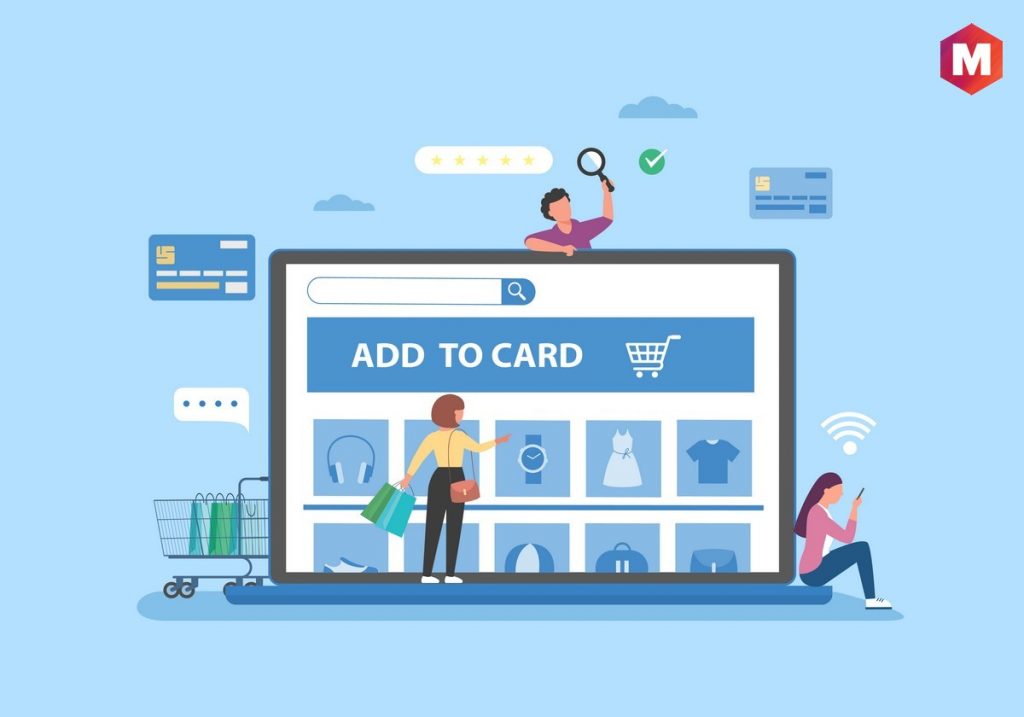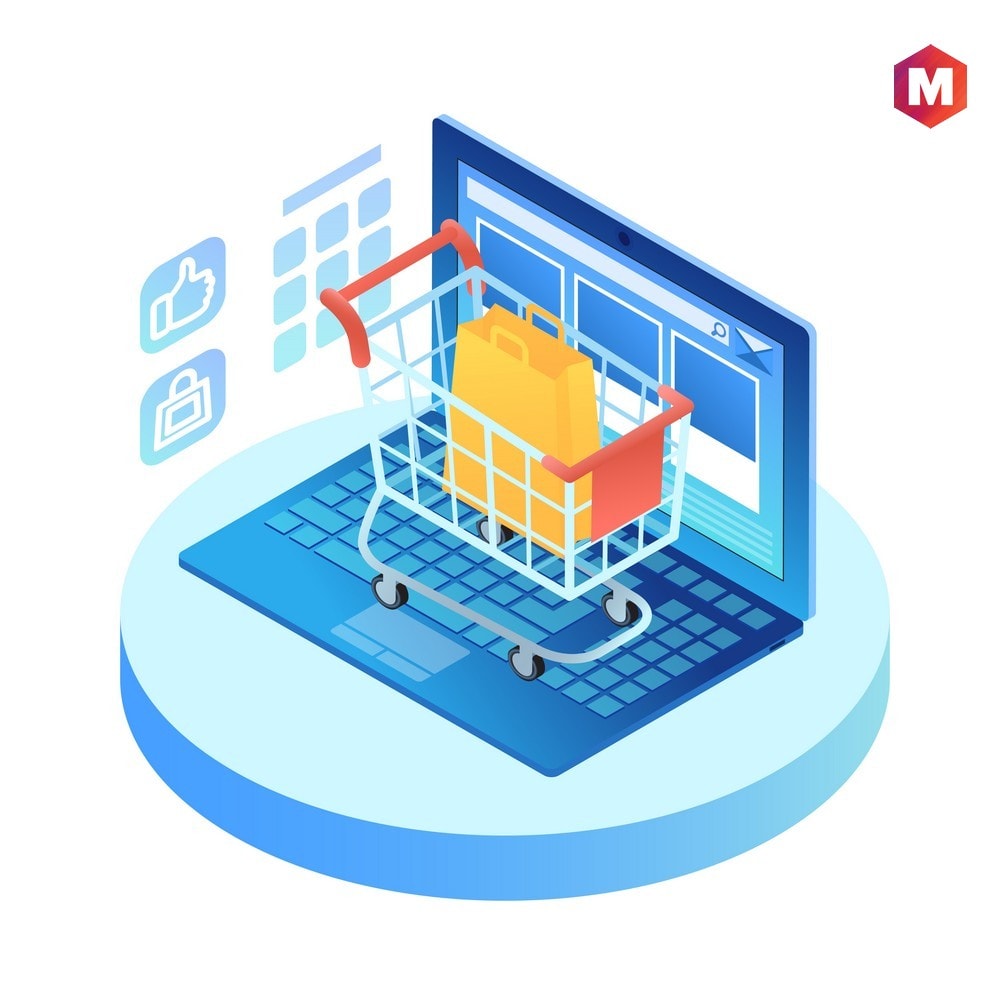Table of Contents
What is e-Commerce?
E-commerce is the buying and selling of goods and services online which includes everything from ordering groceries to booking hotels and buying clothes. Some e-commerce businesses only sell products, while others also provide services. Services can include anything from digital downloads to consultant services.
E-commerce is defined as the businesses as well as the people who buy and sell products and services over the internet. eCommerce is a rapidly growing industry that covers all aspects of buying and selling products and services over the internet. Most of the online transactions as well as mobile commerce businesses are understood as parts of eCommerce.
There are many different types of e-commerce businesses, but they can all be divided into two categories: business-to-consumer (B2C) and business-to-business (B2B). Business-to-consumer e-commerce businesses sell products or services directly to consumers. Amazon, for example, is a B2C e-commerce business. Business-to-business e-commerce businesses sell products or services to other businesses. Alibaba, for example, is a B-2-B e-commerce business.
E-commerce has many benefits over traditional brick-and-mortar shopping. It’s convenient, efficient, and often cheaper. You can shop from the comfort of your own home, and you don’t have to deal with crowds or traffic. You can also shop around for the best deals easily, and compare prices with a few clicks.
Meaning of e-Commerce
E-commerce transactions refer to the buying and selling of goods or services over the Internet. E-commerce businesses can range from small, home-based operations to large, international enterprises. The growth of e-commerce has been explosive in recent years. Global retail eCommerce sales have been growing tremendously.
Several factors are driving this growth. First, the number of people with Internet access is increasing. This is especially true in developing countries, where the number of Internet users has been growing rapidly. Second, the cost of buying goods and services online has been falling. Third, people are becoming more comfortable with making online purchases. And finally, the proliferation of mobile devices like smartphones and tablets has made it easier than ever to shop online.
E-commerce businesses can be divided into two broad categories: online retailers and brick-and-mortar businesses that sell goods and services online. Online retailers are businesses that sell goods and services exclusively online. Online retail businesses typically have no physical storefronts and do not sell through brick-and-mortar retailers. Brick-and-mortar businesses that sell online are businesses that have a physical store as well as an online presence to optimize their offline as well as online sales. These businesses use the Internet to supplement their brick-and-mortar operations by selling goods and services online.
The growth of e-commerce has had a profound impact on the retail sector. The E-commerce site growth has changed the way that people shop and has created new opportunities for businesses. For consumers, e-commerce offers a convenient way to shop for goods and services. For businesses, e-commerce provides a new sales channel and a way to reach new customers.
How does e-commerce work?
An eCommerce store or an online business uses a variety of marketing and sales strategies to attract customers and convert them into buyers.
The most common e-commerce sales model is the online storefront. Online businesses are websites that sell products or services. Customers can browse the website and add items to their shopping cart. When they’re ready to checkout, they enter their shipping information and payment information to process through the payment processing service.
Another common e-commerce sales model is the online marketplace. Marketplaces are platforms that connect buyers and sellers. eBay and Amazon are two of the most popular marketplaces. Marketplace businesses make money by charging fees to sellers.
E-commerce companies can also use subscription models, where customers pay a recurring fee for access to digital products or services. Netflix is a good example of a subscription e-commerce business. Some e-commerce businesses use a combination of sales models. For example, Amazon has an online storefront as well as a marketplace.
Types of e-Commerce
Different types of e-commerce business online shopping and business practices are used such as-
1. Business-to-business (B2B)
B2B e-commerce is when businesses sell products or services to other businesses. The transactions are usually between companies that have a business relationship, such as suppliers and manufacturers.
2. Business-to-consumer (B2C)
B2C e-commerce is when businesses sell products or services to consumers. Transactions can be between a business and an individual consumer or between a business and another business that acts as a consumer, such as a retail store.
3. Consumer-to-consumer (C2C)
C2C e-commerce is when consumers sell products or services to other consumers. The most popular platform for C2C e-commerce is eBay.
4. Consumer-to-business (C2B)
C2B e-commerce is when consumers sell products or services to businesses. An example of C2B e-commerce is when someone sells their handmade goods on Etsy.
5. Business-to-administration (B2A)
B2A e-commerce is when businesses sell products or services to government organizations. An example of B2A e-commerce is when a company sells software to the government.
6. Consumer-to-administration (C2A)
C2A e-commerce is when consumers sell products or services to government organizations. An example of C2A e-commerce is when someone files their taxes online.
Advantages of Electronic Commerce
1. Easy availability or access
eCommerce is available 24 hours a day and 7 days a week. Customers can shop online at any time that is convenient for them.
2. Speed of access
eCommerce is fast. customers can get what they want quickly and easily without having to leave their homes or offices.
3. Wide availability
eCommerce has a wide reach. businesses can sell to customers all over the world with eCommerce.
4. Easy accessibility
eCommerce is easy to use. customers can find what they are looking for quickly and easily.
5. International reach
eCommerce has an international reach. businesses can sell to customers in other countries with eCommerce.
6. Lower cost
eCommerce is usually less expensive than traditional methods of selling, such as brick-and-mortar stores.
7. Personalization and product recommendations
eCommerce businesses can personalize the shopping experience for each customer and provide product recommendations based on customers’ previous purchases.
Disadvantages of e-Commerce
1. Security and privacy concerns
Some people are concerned about the security of their personal information when they shop online. There have been some cases of identity theft and fraud.
2. Lack of human interaction
Some people miss the human interaction that they get when they shop in a brick-and-mortar store. When you shop online, you don’t have the opportunity to ask a salesperson for help or advice.
3. Dependency on technology
eCommerce businesses depend on technology to function. If there is a problem with the website or the payment system, customers cannot shop.
4. Shipping costs and delivery time
Some eCommerce businesses charge for shipping and handling. Customers may also have to wait a few days for their order to arrive.
5. Returns and refunds
Some eCommerce businesses have a no-returns policy. This can be frustrating for customers if they are not satisfied with their purchase.
E-commerce Applications
To bring people to the platform, many retail e-commerce applications employ online marketing strategies such as email, Electronic Data Interchange (EDI), online catalogs, file transfer protocol, shopping carts, web services, mobile applications, etc.
E-commerce platforms are software solutions that provide the necessary technologies and services for businesses to create and operate an online store. These platforms typically include a content management system, a CMS website hosting, a shopping cart and a payment gateway.
Some e-commerce platforms also offer additional features, such as order management, inventory management, shipping, customer service, and marketing tools. Some of the common examples of e-commerce marketplace platforms are Amazon, Alibaba, eBay, Chewy, Overstock, Etsy, Wayfair, Walmart Marketplace, Rakuten, etc.
In addition, several vendors are involved in offering e-commerce platform services, so entrepreneurs or clients can host their own online store sites and some of those are BigCommerce, Magento, Ecwid, Shopify, Oracle NetSuite Commerce, Squarespace, Salesforce Commerce Cloud (B2B and B2C options), WooCommerce, etc.
Government regulations for e-Commerce Businesses
The e-commerce business environment is subject to a variety of laws and regulations, including those related to consumer protection, antitrust, taxation, and data security.
E-commerce businesses must comply with all applicable laws and regulations. Here are some of the most important laws and regulations that e-commerce businesses should be aware of:
1. The Federal Trade Commission Act
This law prohibits unfair or deceptive practices in commerce. It applies to all aspects of e-commerce, including advertising, marketing, and sales.
2. The Sherman Antitrust Act
This law prohibits monopoly practices and other anticompetitive conduct in commerce. It applies to e-commerce businesses that operate in a market with substantial competition.
3. The Children’s Online Privacy Protection Act
This law protects the privacy of children under the age of 13. It requires e-commerce businesses to get parental consent before collecting, using, or disclosing personal information from children.
4. The CAN-SPAM Act
This law regulates commercial email messages. It requires e-commerce businesses to include a valid physical address in their emails and give recipients the option to opt-out of future messages.
E-commerce businesses must also comply with all applicable tax laws and regulations. Failure to do so can result in penalties, including fines and jail time.
There are two types of taxes that e-commerce businesses must pay: sales tax and income tax.
Sales tax is a tax on the sale of goods and services. It is imposed by the state in which the sale occurs.
Income tax is a tax on the income of businesses and individuals. It is imposed by the federal government and by most states. E-commerce businesses must also comply with all applicable data security laws and regulations.
Data security laws and regulations vary by jurisdiction, but they generally require businesses to take reasonable steps to protect the security of customer data. This includes ensuring that data is encrypted, storing data in secure servers, and implementing other security measures. They must also comply with all applicable consumer protection laws and regulations.
Types of Ecommerce Revenue Models
1. Drop Shipping
In drop shipping, eCommerce entrepreneurs sell products without actually stocking them. When a customer orders a product, the entrepreneur contacts the supplier, who then ships the product directly to the customer. This allows eCommerce entrepreneurs to start an online store with very little upfront investment.
2. White Labeling
In white labeling, ecommerce entrepreneurs sell products that are manufactured by another company. The products are usually branded with the eCommerce entrepreneur’s own brand name and logo.
3. Wholesaling
In wholesaling, eCommerce entrepreneurs sell products in bulk to other businesses. The businesses then resell the products to consumers.
4. Private Labeling
In private labeling, eCommerce entrepreneurs create their own brand of products. They then contract with a manufacturer to produce the products. The products are then sold under the eCommerce entrepreneur’s own brand name.
5. Subscription
In subscription commerce, entrepreneurs sell access to a product or service on a recurring basis. For example, an entrepreneur might sell a monthly subscription to a software service.
Example of E-commerce
1. Amazon
Amazon.com is one of the world’s largest e-commerce websites and online marketplaces. It offers a wide variety of products, including books, electronics, apparel, and home goods.
2. eBay
eBay is an e-commerce website that allows users to buy and sell items. It is popular for its auctions, which allow users to bid on items.
3. Alibaba
Alibaba is a Chinese e-commerce website. It is known for its business-to-business services, which allow businesses to connect with suppliers and customers.
4. Etsy
Etsy is an e-commerce website that focuses on selling handmade or vintage items. It is popular with arts and crafts enthusiasts.
5. Uber
Uber is a transportation e-commerce company. It allows users to request and pay for rides from drivers.
How Do You Start an Ecommerce Business?
The first step is to choose a niche. You should choose a niche that you are passionate about. Once you have chosen a niche, you need to create a website. You can create a website using platforms such as WordPress, Shopify, or Wix.
Once your website is created, you need to add products. You can add products by sourcing them from suppliers or by creating them yourself.
Once you have added products to your website, you need to market your eCommerce business. You can promote your store through social media, pay-per-click advertising, or outsourcing your search engine optimization to professionals who can help improve your rankings and organic visibility.
If you follow these steps, you will be well on your way to starting a successful eCommerce business.
Here is a video by Marketing91 on E-commerce.
What Is an Ecommerce Website?
An ecommerce website is a website that allows users to buy and sell products. Ecommerce websites are typically equipped with features such as shopping carts, payment processors, and product catalogs.
Ecommerce websites can be created using platforms such as WordPress, Shopify, or Wix. They can also be created using e-commerce software such as Magento or PrestaShop.
What Is the Difference Between Ecommerce and E-business?
Ecommerce refers to the buying and selling of products or services online. E-business, on the other hand, encompasses all business activities that are conducted online.
Ecommerce is a subset of e-business. All e-commerce businesses are e-businesses, but not all e-businesses are e-commerce businesses.
Conclusion!
E-commerce has come a long way since its humble beginnings as a way to make a few extra bucks by selling goods online. Today, e-commerce is a major force in the global economy, with online sales totaling billions of dollars every year. E-commerce has revolutionized the way we do business, and it shows no signs of slowing down.
Whether you’re a small business owner looking to get started in e-commerce, or a big company looking to take your business to the next level, there’s no doubt that e-commerce is the way to go. So what are you waiting for? Get started today and see the amazing results an eCommerce site can bring!
Liked this post? Check out the complete series on E-Commerce



Thanks for sharing more informative content.